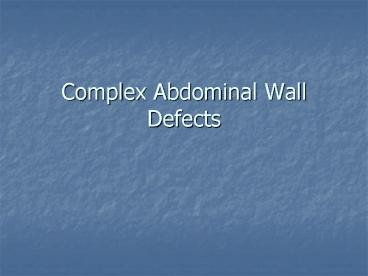Complex Abdominal Wall Defects PowerPoint PPT Presentation
1 / 31
Title: Complex Abdominal Wall Defects
1
Complex Abdominal Wall Defects
2
Muscle and investing fascia
3
Risk Factors
- Wound Infection
- Abdominal Compartment Syndrome
- Trauma
- Infected Mesh
- Incisional Hernia
- Multiple Re-operations through same wound
- Tumor resection
- Obesity, Malnutrition, Sepsis
4
Treatment Options
- Primary Repair
- Mesh Rives-Stoppa
- 3 Stage delayed repair
- Components Separation
- Local flaps v. Free tissue transfer
- Human Acellular Dermis (Alloderm)
5
Primary repair
- Limited to small defect (lt5 cm in diameter)
- Highest recurrence rate (up to 27)
- Patient selection is most important
- Excessive tension leads to ischemia and
failureavoided with mesh and flap
6
Retention sutures
7
Mesh closure
- Nonabsorbable is advocated
- Polypropylene allows for ingrowth of tissue (as
opposed to PTFE) - Important to anchor mesh to well vascularized
tissue - Complications
- Infection, fistula formation, erosion,
continued drainage
8
- Retro-rectus mesh repair ant to posterior
fascia or pre-peritoneal space - 57pts 6 years
- 26.4 prev incisional hernia repair
- ePTFE 8x8 to 20x28cm
- Mean f/u 35 months
- 12.3 Seromas
- Two (3.5) infected mesh removed
- One hernia recurrence(removed prosthesis)
9
Mesh closure
10
Rives-Stoppa
11
Three Staged Closure
- Mostly in pts w/ abdominal compartment syndrome
- Stages
- Absorable mesh / VAC
- STSG
- Ventral hernia repair
12
Components separation
- Oscar Ramirez (1990) describes technique
- Cadaveric dissection
- Incision 1cm lateral to linea semilunaris
- Ext oblique (EO) easily separated from internal
oblique (IO) in AVASCULAR plane - EO has limited advancement
- Rectus w/ IO flap can be advanced
- Unilateral - 5cm epigastrum/10cm middle/3cm
suprapubic
13
Component separation
14
(No Transcript)
15
(No Transcript)
16
- 22 pts / 4yr period
- Defects from 6x10 to 14x24cm
- Causes removal infected mesh, removal of STSG,
trauma abd wall desmoid rsxn - Complications 2 wound infections, 1 seroma, 1
recurrent hernia
17
(No Transcript)
18
(No Transcript)
19
(No Transcript)
20
(No Transcript)
21
Goals of abdominal wall reconstruction
- Restoration of function and integrity of the
abdominal wall - Prevention of evisceration
- Dynamic muscle support
22
(No Transcript)
23
Flap closure
- Flap selection based on location and arc of
rotation - High success rate when combine with mesh
24
Common flaps used
25
Free tissue transfer?
- Requires adequate recipient vessels
- Allows to transfer innervated muscle
- Technically more demanding
26
Acellular Cadaveric Dermis (Alloderm)
27
- Goal 3 stage ? single operation
- Bilateral bipedicle advancement flaps
- Incisions _at_ anterior axillary lines-undermine _at_
junction of SQ fat anterior fascia - Donor site w/ STSG
- 9 Pts followed for mean 20 months
- Conclusion
28
(No Transcript)
29
(No Transcript)
30
(No Transcript)
31
Transplantation of the abdominal wall

